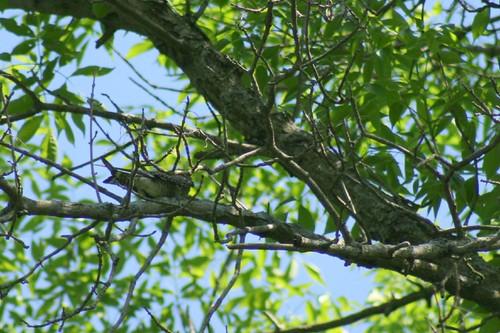July can be a rather lackluster month for birding in Canada. The June rush of babies everywhere has faded, waterfowl go into eclipse moult, and temperatures are just too high to entice me to go looking.
A case in point is the recent trip we took to a neighbouring province. We were in a lovely little wooded valley that contained four large lakes. For three days, the Humidex was 40C, or 110F. Active birding wasn't even contemplated, and our bird watching was restricted to watching flocks of White Pelicans float about overhead.
Upon our return, I discovered I had received a copy of the new State of Canada's Birds Report put out by the North American Bird Conservation Initiative. The report draws on 40 years of data, and is the first document produced on the health of our birds. I knew it was coming, but it sat on my desk for several days while I summoned up the courage to face that much reality.
When I finally opened it I saw that on average, Canadian breeding bird populations have decreased by 12% since 1970, which is when effective monitoring began. Well, that didn't seem as bad as I was expecting, but the key phrase there was 'on average'.
All birders have a favourite species or two, and a story to go along with it. In my case, one of those special birds is an insectivore, the Common Nighthawk. When I was a little girl these birds really were common, and we heard them every evening. My dad would say there's the rainbird - their cry means rain is coming - and to this day their call takes me back to warm summer evenings, watching the sky with my father.
Three years ago we camped along the Red Deer River in southern Alberta, and watched 15 or 16 nighthawks every evening. This month we camped there again, and there were two. It’s very hard not to take this personally.
 |
| Common Nighthawk by Daniel Arndt |
Aerial insectivores are declining more rapidly than any other group of birds, and some formally common species like the Barn Swallow and Chimney Swift have declined to less than a quarter of their pre-1970 levels. Twenty-two of the 26 species that breed in Canada are declining, with swifts, swallows and nightjars - Common Nighthawk and Eastern Whip-poor-will - showing the most alarming changes.
 |
| Barn Swallow by Daniel Arndt |
As bad as the statistics are for insectivores, they’re worse for shorebirds, whose populations have declined by almost half. These long distance migrators are being affected by loss of wetland habitat on all stages of their journey, from their breeding grounds in Canada to stopover sites and wintering grounds throughout the Western Hemisphere.
Grassland bird populations are also declining, but at least there is some good news mixed in with the bad. Longspurs, meadowlarks, Sprague’s Pipit, Greater Sage-grouse and others, have declined by 50%. McGown’s Longspurs have declined by 90%. Populations are dwindling as high-intensity farming practices like wetland drainage, conversion of pastureland to cropland and over-grazing remove and degrade habitat
The prairies however, also support millions of breeding ducks and other waterbirds whose populations have increased, largely due to more sustainable hunting management and protection or restoration of wetlands.
Raptors are another success story, and their populations are continuing to recover since the banning of chemical pesticides in the early 1970’s. Osprey and Bald Eagle populations have doubled or tripled. Peregrine Falcons have increased due to release of captive-bred individuals. Merlins, Cooper’s and Broad-winged Hawks are becoming more common in urban environments, likely due to the abundance of prey species around bird feeders. The news is not so good for the little insect-eating American Kestrel or the Northern Harrier though, whose populations have declined by 60%.
Burrowing Owls can successfully co-exist with man on well-managed grasslands, but disappear completely from pastureland that is over-grazed, or converted to cropland. Many Burrowing Owls that breed in Canada do not return from their winter migration, and only half of the adults come back to their northern breeding grounds.
The Canadian Arctic provides nesting grounds for millions of birds. Overall indicators for this area have changed little in the last 40 years because the figures combine dramatic increases in waterfowl (Snow Geese populations have increased 300%) with steep declines in shorebirds. The Canadian coastline supports about 15 million breeding seabirds whose populations have increased, reflecting a long term recovery from historical over-hunting.
I was surprised to read the Snowy Owl population has also declined by more than half in the last 40 years. Given the amazing irruption of snowys last winter, birders in the lower latitudes may be forgiven for thinking their overall population is doing well. It will be interesting to see how many sightings there are this coming winter.
The vast expanse of the boreal forest is a nursery for billions of birds. Due to its enormous size and inaccessibility, monitoring the status of boreal birds is restricted to the southern edges, where habitat modification is highest. The only group of birds that have been effectively monitored throughout the forest is waterfowl, as they’re counted from the air by helicopter or small airplane. Whooping Cranes have recovered from an all time low of 15 birds, to 2011 figures of 430 in the wild and 160 in captivity. The report also states that Common Goldeneye and American Bittern have declined strongly, leading me to wonder how on earth do you even see, much less count, American Bitterns from a helicopter?
 |
| Whooping Crane at the Calgary Zoo off-exhibit breeding centre |
Overall, the forest species show little change. Some resident species like Pileated Woodpecker, Common Raven and Red-breasted Nuthatch have shown strong population increases. Many migratory species such as warblers have declined, as shrub and forest edge birds are showing the steepest drop in numbers.
Only 22% of Canada’s breeding birds stay here year round and these are the species that have shown little change or even increases in their population.
It’s the hazards of migration that are taking the heaviest toll on birds. Species that migrate the farthest – from Canada to South America – are declining the fastest. International cooperation on a hemispheric level is the only thing that will allow future birders to puzzle over the identification of a shorebird.
It has never been more important for birders to speak out on behalf of our avian friends. People can’t help unless they know about the problem, so let’s get out there and recruit more birdwatchers!






















































